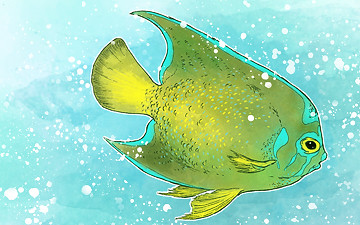The queen angelfish (Holacanthus ciliaris) is an angelfish commonly found near reefs in the warmer sections of the western Atlantic Ocean.
The adult queen angelfish overall body color can be described as blue to bluegreen with yellow rims on its scales. Their pectoral fins and ventral fins are also yellow but their lips and the edges of their dorsal fins and anal fins are dark blue. Queen angelfish are also known to have blue markings around each gill cover. Juveniles have dark blue bodies with yellow lips, gills, and tail and vertical bars ranging in color from light blue to white. The queen angelfish may live up to 15 years in the wild and reach up to 45 centimetres in length. Queen angelfish are about three and a half pounds.
The queen angelfish feeds primarily on sponges, but also feeds on tunicates, jellyfish, and corals as well as plankton and algae. Juveniles serve as “cleaners” and feed on the parasites of larger fish at cleaning stations. Although in home aquariums, aquarists have been successful in providing the queen angelfish a diet of meaty and algae based foods
Queen angelfish inhabit reefs and are common near Florida, the Bahamas, and the Gulf of Mexico. It is rarely seen in the Bermuda Triangle and as far south as Brazil.
(From Wikipedia, June 11, 2010)
– – –
Found on coral reefs. Generally occurs solitarily or in pairs. Moves gracefully between seafans, seawhips, and corals (Ref. 9710). Stomach contents of 26 specimens indicate that the species feeds almost exclusively on sponges supplemented by small amounts of algae, tunicates, hydroids and bryozoans. Young pick ectoparasites from other fishes (Ref. 9710). Marketed fresh (Ref. 3797).
(From EOL via Fishbase)
– – –




